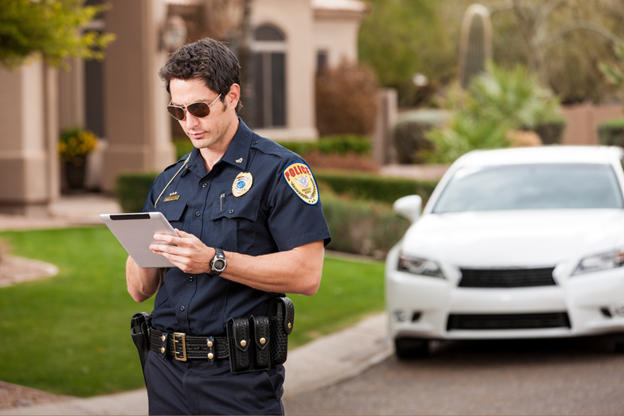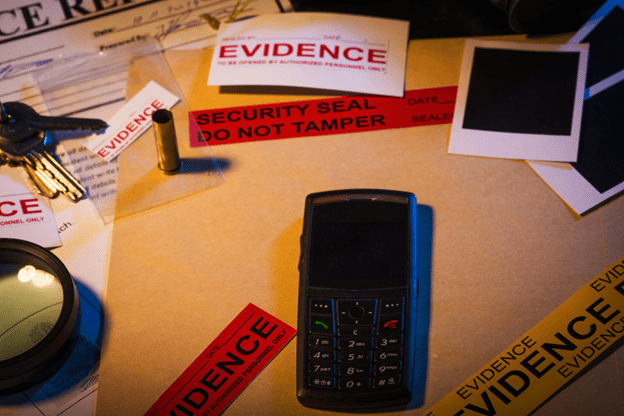Law Enforcement Transcription: The Ultimate 2025 Guide
Learn the ins and outs of law enforcement transcription, including how to save time and increase efficiency using law enforcement transcription services.

When it comes to transcribing interactions that will be used in legal cases, speed and accuracy are everything. Missing a single word in an interview, body-cam recording, or 911 call could mean losing evidence—or worse, losing a case.
But scrubbing through hours of audio and video can take days or even weeks, and that’s a time-suck no one can afford. Take the weight off your shoulders and get much-needed time back with law enforcement transcription.
Law enforcement transcription turns hours of audio or video into precise, ready-to-use transcripts. Become a law enforcement transcription expert after reading this guide from top to bottom!
What is Law Enforcement Transcription?
Law enforcement transcripts are text-based records of conversations that are needed in a legal matter, such as investigations, legal cases, or for public transparency and accountability.
Because of their use, accuracy is an absolute must. Missing key details could misconstrue what took place, or even change the tide in a case or trial.
Benefits of Law Enforcement Transcripts
Law enforcement transcripts are invaluable tools that go beyond simply recording conversations. They bring clarity, efficiency, and even cost savings to a profession where every detail matters. Here’s how these benefits make a difference:
Transcripts ensure accuracy and boost efficiency.
In investigations, every word counts. Transcripts provide an exact, word-for-word record of interviews, 911 calls, and body-cam footage, removing the guesswork. They make it easy to search for key details, reducing the need to replay hours of audio.
They improve case management.
Organized, searchable transcripts help law enforcement professionals connect the dots between incidents, interviews, and evidence. Transcripts make sure everyone involved has access to the same information, reducing confusion and improving collaboration.
Transcripts save time and cut costs.
Time is money—especially in law enforcement. Transcripts eliminate the need for repetitive audio reviews, allowing investigators and attorneys to focus on the bigger picture. Transcripts help agencies work smarter—not harder.
4 Common Types of Law Enforcement Transcription
There are four common types of law enforcement transcription. Here’s the breakdown:
#1 – Interviews and interrogations
Interviews and interrogations are the foundation of a case. Witnesses recounting what they saw, or a suspect giving testimony, play a vital role as evidence.
These transcripts provide an exact record for lawyers, investigators, and court reporters, ensuring that nothing gets lost in translation (often literally).
#2 – Body-cam footage
Everything from routine traffic stops to high-stakes burglaries and home invasions are captured by body cameras worn by law enforcement. It’s essential to transcribe the footage so a clear, searchable record of events exists.
This allows the event to be keyword searchable, indexed for evidence, and presented in court if need be. It’s vital for accountability and transparency in law enforcement.
#3 – 911 calls
A lot of raw, unfiltered information is shared in an urgent 911 call. Transcription turns a chaotic, fast-paced exchange into an organized, actionable record to be preserved and indexed for later reference.
These transcripts help investigators organize timelines, understand details, and provide context in critical trials.
#4 – Incident reports
An officer will take handwritten notes during an incident. These notes need to be turned into official documentation later through the process of transcription.
Transcribing these reports turns handwritten notes or dictated recordings into structured documents that can be archived, analyzed, or presented as evidence.
How Law Enforcement Transcripts Are Used

Transcripts in law enforcement play a critical role in solving crimes, building trust, and ensuring justice. Let’s break down some of the key ways these transcripts are used.
Strong foundational evidence
A clear transcript can give a case the edge it needs to stand up to scrutiny. Evidence transcripts capture every word exactly as it was said. This accuracy is crucial for spotting inconsistencies, supporting evidence, and presenting airtight arguments in court.
More accurate and efficient investigations
Personally analyzing hours of audio recordings to find one key piece of information isn’t exactly efficient. Transcripts make the process smoother by turning raw audio into searchable, organized documents that can be easily cross-checked against other sources to build a fuller picture of what took place. This process is excellent for private investigations as well.
One shared source of information
Courtrooms are all about clarity. A written record allows judges, juries, and attorneys to follow along without struggling to decipher audio. They make referencing specific details during testimony or appeals easy, ensuring nothing gets lost in the shuffle.
Accountability and trust
Transcripts are a powerful tool for accountability. By documenting interactions—like those recorded on body cams or during an incident—transcripts provide a clear, unbiased record of what happened. This transparency fosters public trust and protects officers by clarifying events.
Critical information preservation
Cases don’t always get solved immediately, and some details don’t seem important until later. Having transcripts archived means that investigators can revisit them months or years down the line.

Law Enforcement Transcription Services
One hour of content takes an officer an average of four hours to transcribe. That’s a lot of time spent on paperwork! But it doesn’t have to be this way thanks to transcription services. There are a few different routes available for law enforcement transcription services.
Each service has its advantages and disadvantages, so let’s break down what you can expect of each one.
AI transcription services
AI-powered transcription services use artificial intelligence to transcribe audio quickly and cost-effectively. These tools excel at speed, making them ideal for processing large volumes of audio in a short time.
While they’ve become more accurate over time, AI transcription may still struggle with heavy accents, poor audio quality, or highly technical jargon, making a review necessary.
#1. Rev
Rev’s AI transcription service offers a fast and affordable way to turn audio into text. While it may not have the precision of human transcription, it’s ideal for quick, less critical tasks like preliminary reviews or processing large volumes of recordings.
#2. Otter.ai
Otter.ai stands out with its real-time transcription capabilities, making it perfect for live recordings, interviews, or meetings. Its AI is designed to handle conversational audio efficiently, providing immediate access to a draft transcript.
#3. Ditto
Ditto’s AI transcription services specialize in producing fast and accurate drafts tailored for professional use. Its algorithms are built to recognize a variety of accents and handle challenging audio, which is needed for law enforcement agencies.
AI Transcription Tools Comparison | |||
Service | Price | Turnaround Time | Best Use Case |
Rev | $0.25/min | Minutes | Processing large volumes of recordings quickly |
Otter.ai | Free – $30/month | Real-time | Real-time transcription for meetings and interviews |
Ditto | Custom Pricing | Minutes | Fast, accurate drafts for diverse and challenging audio |
Human transcription services
Traditional human transcription remains the gold standard for accuracy, especially when dealing with complex audio or legal terminology. Professionals with experience in law enforcement transcription can interpret nuances and ensure the highest level of precision.
Hybrid transcription services
This method uses AI to generate a draft transcript, which is then reviewed and polished by a human transcriptionist. Hybrid solutions are ideal for agencies who need to balance cost, speed, and precision.
Human Law Enforcement Transcription with SpeakWrite

SpeakWrite is a 100% human-powered transcription service that specializes in industry-specific transcription. They offer unparalleled accuracy, speed, and security that is always tailored specifically to the needs of police departments, law offices, and investigative agencies.
SpeakWrite has unmatched accuracy in transcription.
Accuracy isn’t optional when it comes to law enforcement transcription. SpeakWrite’s team of highly trained transcriptionists, based in the U.S. and Canada, knows legal and law enforcement language nuances and will deliver a professional, accurate transcript.
SpeakWrite gets transcripts to you faster than you’d expect.
When time is critical, SpeakWrite rises to the occasion. With most transcriptions completed within about three hours, you’ll have the information you need to keep investigations moving.
Submitting audio files to SpeakWrite is effortless and flexible.
Whether you’re in the field or at the station, SpeakWrite adapts to how you work. Their submission options include a free mobile or desktop app, a user-friendly web portal, direct links from platforms like Google Drive or Dropbox, and even a toll-free dictation line.
SpeakWrite saves you valuable time and energy.
Document transcription can take hours, but it doesn’t have to. By using SpeakWrite, departments have reported saving an average of 54 hours per month on employee time alone. That’s time officers can spend on investigations, patrols, or community engagement—not buried in paperwork.
SpeakWrite protects your sensitive information.
SpeakWrite uses advanced security measures to ensure that your data remains protected throughout the entire transcription process. You can trust that sensitive recordings and documents are handled carefully, giving you one less thing to worry about.
Step-by-Step Guide for Lan Enforcement Transcription with SpeakWrite
Getting a law enforcement transcript doesn’t have to be a hassle—SpeakWrite makes the process fast, simple, and reliable. Here’s how to go from audio to a polished, professional transcript in just a few easy steps:
Step #1: Start by creating a SpeakWrite account.
First things first—head to SpeakWrite’s website and set up an account. This unlocks access to all their tools, including a user-friendly app that’s perfect for on-the-go transcription needs.
Once you’re in, grab the app for your mobile device or desktop—it’s the ultimate tool for recording, uploading, and managing your audio files. Whether you’re at the station or out in the field, the app makes submitting transcription requests ridiculously easy.
Step #2: Record your audio.
Use the SpeakWrite app or your go-to recording device to capture interviews, 911 calls, or body-cam audio. SpeakWrite works with every common audio format, so you’re covered no matter what you’re using.
Already have a recording? No problem—you’re ready for the next step.
Step #3: Upload your file.
Upload your audio straight through the app or the SpeakWrite web portal. Prefer cloud storage? You can submit files from Dropbox, Google Drive, or even YouTube links.
Include any details that’ll make your transcript perfect—speaker names, case numbers, or formatting preferences. The more info you provide, the more tailored the final transcript will be.
Step #4: Submit your file and let SpeakWrite do the heavy lifting.
Hit “Submit” and watch the magic happen. Your file heads straight to a team of professional transcriptionists who specialize in law enforcement. They’re already on it.
SpeakWrite knows time is critical, so most transcripts are ready in about three hours. You can even request expedited delivery if you’re on a tight deadline. No dragging your feet here.
Step #5: Review and download the finished transcript.
Once it’s ready, you’ll get a notification. Take a moment to review it, but don’t stress—SpeakWrite’s 99% accuracy guarantee means you’re in good hands.
When it looks good, download the final file and save it wherever needed. Whether it’s on your desktop or in a secure archive, your transcript is ready to use.
Step #6: Now put that transcript to work.
Now comes the fun part—using your transcript to tackle your next big task. Whether it’s evidence for court, case prep, or archiving for future reference, SpeakWrite gives you a professional document you can trust.

In 2015, a California police department hit a staffing crunch when their word processing team was cut in half. With over 300 officers serving a population of 200,000, they needed a way to handle the growing backlog of reports and interview transcripts without gluing officers to their desks.
SpeakWrite stepped up to handle the overflow. Detectives used it for tough interviews, and patrol officers submitted dictations for quick-turnaround reports. It was simple and efficient and allowed officers to review drafts before finalizing them.
The results? They saved 54 hours of employee time every month—basically freeing up seven 8-hour shifts. One admin summed it up perfectly: “If you’re looking for speedy returns, SpeakWrite can assist you.”
Law Enforcement Transcription: Frequently Asked Questions
How to become a law enforcement transcriptionist?
To become a law enforcement transcriptionist, you’ll need fast typing skills (60-80 words per minute), a keen ear for detail, and a solid understanding of legal or law enforcement terminology. A high school diploma is usually required, and additional training or certification in transcription can give you an edge. SpeakWrite offers opportunities for skilled transcriptionists to work with law enforcement audio, providing flexible work and competitive pay.
How do I transcribe a conversation for law enforcement use?
When it comes to transcribing a conversation for legal purposes, you’ve got options. Human services are best for accuracy but slower on time. All AI services come with quick turnarounds but still struggle with things like fuzzy audio or heavy accents. A hybrid approach like SpeakWrite’s uses a combination to provide the speed of AI services with the accuracy of human transcription.
Is legal transcription still in demand?
Yes, legal transcription remains in demand due to the continued need for accurate documentation in legal and law enforcement fields. As courts, attorneys, and police departments rely heavily on written records, the demand for skilled transcriptionists continues to grow – especially with advancements in technology supplementing, but not replacing, human expertise.
When inaccuracy isn’t an option, and every detail matters, you need a trusted transcription service.
SpeakWrite is built for the fast-paced, high-stakes demands of law enforcement. Whether it’s witness interviews, body-cam footage, or incident reports, they deliver accurate, secure, and fast transcripts so you can focus on protecting your community.
With SpeakWrite, you’re not just getting transcription—you’re getting a team that understands the unique challenges of law enforcement. SpeakWrite’s approach helps you save time, reduce stress, and stay ahead, all while ensuring your data is handled with the highest level of security.
Don’t let backlogs slow you down. Partner with SpeakWrite and experience transcription that works as hard as you do. Ready to see the difference?
